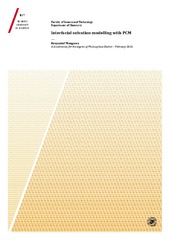| dc.contributor.advisor | Frediani, Luca | |
| dc.contributor.author | Mozgawa, Krzysztof | |
| dc.date.accessioned | 2016-07-15T10:39:04Z | |
| dc.date.available | 2016-07-15T10:39:04Z | |
| dc.date.issued | 2016-02-17 | |
| dc.description.abstract | The effect of surfaces and interfaces on the molecular properties and structure is of a great interest in the applied sciences and technology. In the following thesis, a theoretical framework for the calculations of the free energy and properties, including the effect of interfaces and surfaces, in quantum-mechanical formalism is presented. The model of choice is Polarizable Continuum Method (PCM), which is an implicit and versatile way to include solvent-related effect in the QM calculations. The classical implementation of this model is available in most of popular QM program suites, regrettably usually only including electrostatic effects. Within the following thesis a formalism to include the non-electrostatic contributions (mainly dispersion and repulsion) in the calculation is derived and discussed, together with the extension to surfaces and interfaces. Thesis is closed with three papers/manuscripts based on the current results of the presented model. | en_US |
| dc.description.doctoraltype | ph.d. | en_US |
| dc.description.popularabstract | Overflater finnes overalt i naturen og deres unike egenskaper er meget viktige for verden omkring oss. Havoverflaten har stor innflytelse på klimaet, cellemembraner styrer blant annet transport av molekyler inn og ut av cellene, egenskapene til nanomaterialer er annerledes enn makroskopiske systemer fordi en stor andel av molekylene sitter på overflaten. Samtidig er det utfordrende å undersøke molekyler som befinner seg på overflater, fordi selve overflaten er veldig tynn, samtidig som den skiller mellom to deler som har veldig ulike egenskaper. Eksperimentelt er man nødt til å utnytte avanserte spektroskopiske metoder som er spesifikke for overflater. Modellering kan derfor være et nyttig verktøy både for å tolke eksperimentelle data og for å for å forutsi hvordan molekyler oppfører seg i nærheten av overflater. Et viktig spørsmål er f.eks. om et bestemt molekyl vil foretrekke å være på overflata eller ikke, og ikke minst, hvordan overflaten påvirker egenskapene av molekylet selv. I denne avhandlingen har det blitt utviklet en modell som vil gjøre oss i stand til å gi svar på dette spørsmålet. | en_US |
| dc.description.sponsorship | PhD grant through University of Tromsø | en_US |
| dc.description | The papers of this thesis are not available in Munin.<br>
Paper I. Mozgawa K, Mennucci B, Frediani L.: Solvation at surfaces and interfaces: a quantum-mechanical/continuum approach including nonelectrostatic contributions. Available in <a href=http://dx.doi.org/10.1021/jp4117276>Journal of Physical Chemistry C 2014, 118, 4715−4725</a><br>
Paper II. Mozgawa K, Frediani L.: Electronic structure of small surfactants: a continuum solvation study. (Manuscript). <br>
Paper III. Di Remigio R, Mozgawa K et al.: A polarizable continuum model for molecules at spherical diffuse interfaces.(Manuscript). Published version available in <a href=http://dx.doi.org/10.1063/1.4943782>Journal of Chemical Physics 144, 124103 (2016)</a> | en_US |
| dc.identifier.isbn | 978-82-8236-206-1 (printed version), 978-82-8236-207-8 (electronic/ pdf version) | |
| dc.identifier.uri | https://hdl.handle.net/10037/9480 | |
| dc.identifier.urn | URN:NBN:no-uit_munin_9035 | |
| dc.language.iso | eng | en_US |
| dc.publisher | UiT Norges arktiske universitet | en_US |
| dc.publisher | UiT The Arctic University of Norway | en_US |
| dc.rights.accessRights | openAccess | |
| dc.rights.holder | Copyright 2016 The Author(s) | |
| dc.rights.uri | https://creativecommons.org/licenses/by-nc-sa/3.0 | en_US |
| dc.rights | Attribution-NonCommercial-ShareAlike 3.0 Unported (CC BY-NC-SA 3.0) | en_US |
| dc.subject | VDP::Mathematics and natural science: 400::Chemistry: 440::Theoretical chemistry, quantum chemistry: 444 | en_US |
| dc.subject | VDP::Matematikk og Naturvitenskap: 400::Kjemi: 440::Teoretisk kjemi, kvantekjemi: 444 | en_US |
| dc.title | Interfacial solvation modelling with PCM | en_US |
| dc.type | Doctoral thesis | en_US |
| dc.type | Doktorgradsavhandling | en_US |


 English
English norsk
norsk
